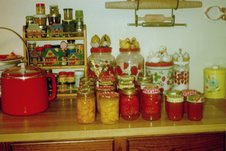TiPs for handling and cooking chicken
1. Don't rinse the chicken - that just spreads bacteria. You can pat it dry with towels (paper or clean cloth).
2. If you use a plastic cutting board, sanitize it afterwards in a dishwasher. Wood can be hand washed with a sanitizing solution (I prefer vinegar and salt to bleach).
3. Wash your hands well and often; be careful to clean under fingernails. Using plastic gloves works too.
4. The USDA recommended temperature for cooked chicken has been revised to 165°. (It used to be higher.)
5. Use an instant-read thermometer - you can't tell if it's done just by looking. You might want to check the temperature in more than one location, such as the thickest part of the thigh and breast, being careful not to touch bone.
6. When buying poultry, check the sell-by date and buy the one farthest out.
7. Cook within 2 days of buying, regardless of sell-by date. Home refrigerators are warmer than store fridges.
8. Save the scraps - bones, trimmings, giblets. You can add them to a freezer bag and freeze to make broth later.*
9. Save the fat! It's healthier than you may think - high in helpful fats and low in polyunsaturated fats.
10. Cook at a moderate temperature - high temperature or broiling can dry it out and cook unevenly (too done/dry outside, not done inside.)
*to make broth:
· Put the bones** and scraps in a pot (a crockpot works well) and cover with water.
· Add some onion, carrot, celery, herbs (thyme, bay leaf, sage).
· Turn the heat to "low" and bring SLOWLY to a simmer. (DO NOT BOIL or it will turn cloudy and muddy-looking.)
· Cover and simmer for 2 to 6 hours.
· Strain the broth through a fine sieve or cheese-cloth lined colander.
· Discard the scraps and the vegetables.
· Season the broth to taste with salt.
· Pour the broth into containers (such as quart size yogurt tubs or wide-mouth canning jars).
· Chill the strained broth in the fridge for 12 - 24 hours.
· When chilled, the fat will rise to the top and form a solid layer that is easy to remove.
· Save the fat***! You can store it in small 1/2 cup containers and freeze.
· If the broth is solid (jelled) when chilled, that is a good thing! It means it is full of protein and flavor!
· You can use the broth right away or freeze. Freeze in 1 cup containers for ease of use.
· To make soup - add cooked vegetables, rice, noodles, lemon juice, ginger, etc. and heat.
**An option: To give the broth a darker, roasty flavor, roast the bones in a 350° oven for 30 minutes before making broth.
Thursday, April 21, 2011
Tuesday, April 12, 2011
Spring Vegetables
The local people in West Virginia told us that you need to eat greens in the Springtime to thin your blood (which got thick during the winter to keep you warm). So in that spirit, here are two spring vegetables I made today. I saw that the mint is starting to leaf out in my garden so it is time to make Minted Peas.
MINTED PEAS
First, I put some frozen baby peas in pan, added a little water and brought it to a boil. Then I shocked the peas in cold water and drained them. Put 'em in a bowl.
Chopped some fresh mint leaves, and the first baby chives from the garden.
Put the mint in the peas.
Warmed the chives in a tablespoonful of olive oil/butter in a pan, and added this to the peas.
+++++++++++++++++++++++++++++++++++
HERBED ARTICHOKE HEARTS
Frozen baby artichokes are available at Trader Joe's. I simmered them in a covered pan with a little water, Then drained them in a colander.
Added some lemon zest:
Heated some chicken Schmaltz that I had saved and frozen from when I made a herb roasted chicken, and sauteed some garlic:
Added some oregano and black pepper, and seasalt:
Tossed back in the artichokes to warm them, with a squeeze of lemon juice:
SPRING VEGETABLES ! :
Served with some red Canada herbal tea:
MINTED PEAS
First, I put some frozen baby peas in pan, added a little water and brought it to a boil. Then I shocked the peas in cold water and drained them. Put 'em in a bowl.
Chopped some fresh mint leaves, and the first baby chives from the garden.
Put the mint in the peas.
Warmed the chives in a tablespoonful of olive oil/butter in a pan, and added this to the peas.
+++++++++++++++++++++++++++++++++++
HERBED ARTICHOKE HEARTS
Frozen baby artichokes are available at Trader Joe's. I simmered them in a covered pan with a little water, Then drained them in a colander.
Added some lemon zest:
Heated some chicken Schmaltz that I had saved and frozen from when I made a herb roasted chicken, and sauteed some garlic:
Added some oregano and black pepper, and seasalt:
Tossed back in the artichokes to warm them, with a squeeze of lemon juice:
SPRING VEGETABLES ! :
Served with some red Canada herbal tea:
Subscribe to:
Posts (Atom)




















